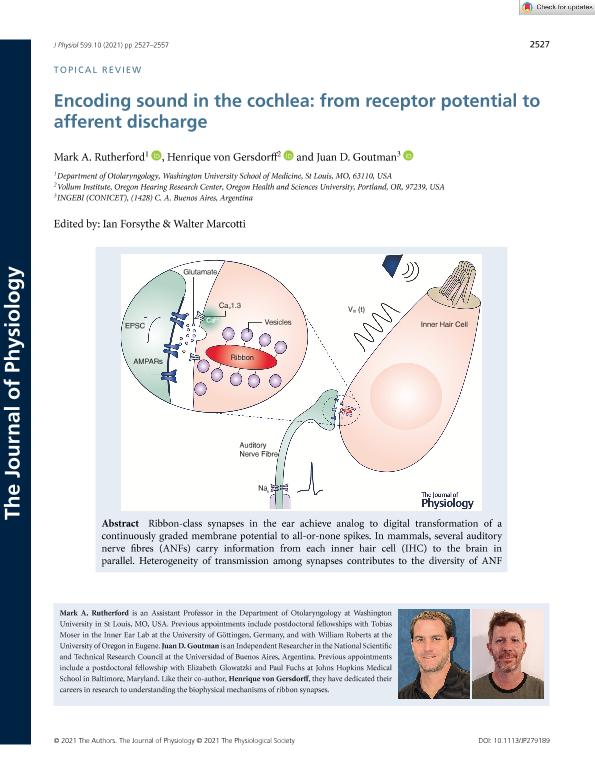Mostrar el registro sencillo del ítem
dc.contributor.author
Rutherford, Mark A.
dc.contributor.author
von Gersdorff, Henrique
dc.contributor.author
Goutman, Juan Diego

dc.date.available
2021-08-09T19:03:43Z
dc.date.issued
2021-05
dc.identifier.citation
Rutherford, Mark A.; von Gersdorff, Henrique; Goutman, Juan Diego; Encoding sound in the cochlea: from receptor potential to afferent discharge; Wiley Blackwell Publishing, Inc; The Journal Of Physiology; 599; 10; 5-2021; 2527-2557
dc.identifier.issn
0022-3751
dc.identifier.uri
http://hdl.handle.net/11336/138050
dc.description.abstract
Ribbon-class synapses in the ear achieve analog to digital transformation of a continuously graded membrane potential to all-or-none spikes. In mammals, several auditory nerve fibres (ANFs) carry information from each inner hair cell (IHC) to the brain in parallel. Heterogeneity of transmission among synapses contributes to the diversity of ANF sound-response properties. In addition to the place code for sound frequency and the rate code for sound level, there is also a temporal code. In series with cochlear amplification and frequency tuning, neural representation of temporal cues over a broad range of sound levels enables auditory comprehension in noisy multi-speaker settings. The IHC membrane time constant introduces a low-pass filter that attenuates fluctuations of the receptor potential above 1?2 kHz. The ANF spike generator adds a high-pass filter via its depolarization-rate threshold that rejects slow changes in the postsynaptic potential and its phasic response property that ensures one spike per depolarization. Synaptic transmission involves several stochastic subcellular processes between IHC depolarization and ANF spike generation, introducing delay and jitter that limits the speed and precision of spike timing. ANFs spike at a preferred phase of periodic sounds in a process called phase-locking that is limited to frequencies below a few kilohertz by both the IHC receptor potential and the jitter in synaptic transmission. During phase-locking to periodic sounds of increasing intensity, faster and facilitated activation of synaptic transmission and spike generation may be offset by presynaptic depletion of synaptic vesicles, resulting in relatively small changes in response phase. Here we review encoding of spike-timing at cochlear ribbon synapses.
dc.format
application/pdf
dc.language.iso
eng
dc.publisher
Wiley Blackwell Publishing, Inc

dc.rights
info:eu-repo/semantics/openAccess
dc.rights.uri
https://creativecommons.org/licenses/by-nc-sa/2.5/ar/
dc.subject
FIRST-SPIKE LATENCY
dc.subject
PHASE-LOCKING
dc.subject
RECEPTOR POTENTIAL
dc.subject
RIBBON SYNAPSE
dc.subject
SYNAPTIC DELAY
dc.subject
TEMPORAL CODE
dc.subject.classification
Neurociencias

dc.subject.classification
Medicina Básica

dc.subject.classification
CIENCIAS MÉDICAS Y DE LA SALUD

dc.title
Encoding sound in the cochlea: from receptor potential to afferent discharge
dc.type
info:eu-repo/semantics/article
dc.type
info:ar-repo/semantics/artículo
dc.type
info:eu-repo/semantics/publishedVersion
dc.date.updated
2021-07-30T19:18:33Z
dc.identifier.eissn
1469-7793
dc.journal.volume
599
dc.journal.number
10
dc.journal.pagination
2527-2557
dc.journal.pais
Estados Unidos

dc.journal.ciudad
Hoboken
dc.description.fil
Fil: Rutherford, Mark A.. Washington University in St. Louis; Estados Unidos
dc.description.fil
Fil: von Gersdorff, Henrique. Oregon Health and Sciences University; Estados Unidos
dc.description.fil
Fil: Goutman, Juan Diego. Consejo Nacional de Investigaciones Científicas y Técnicas. Instituto de Investigaciones en Ingeniería Genética y Biología Molecular "Dr. Héctor N. Torres"; Argentina
dc.journal.title
The Journal Of Physiology

dc.relation.alternativeid
info:eu-repo/semantics/altIdentifier/doi/http://dx.doi.org/10.1113/JP279189
dc.relation.alternativeid
info:eu-repo/semantics/altIdentifier/url/https://physoc.onlinelibrary.wiley.com/doi/pdf/10.1113/JP279189
Archivos asociados
